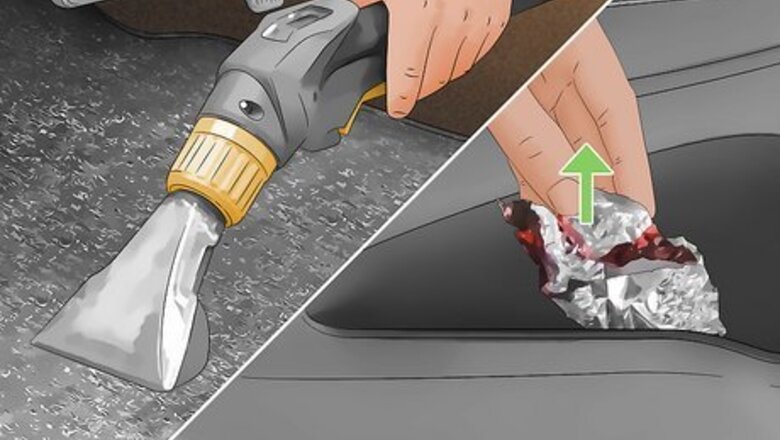
views
- Declutter and deep clean your car to remove roaches’ food source. You can also use a mixture of sugar and baking soda or Borax to kill roaches inside.
- To prevent roaches from coming back, close your car doors and windows, try to keep your car clean, park in clean areas, and seal any cracks or seams.
- Roaches like warmth, food (especially if it’s fermented), and water. These might be found in cars, where people might drop food crumbs or spill drinks.
Getting Rid of Roaches in Cars

Declutter and vacuum your car. Wear a mask, gloves, and goggles to protect yourself against bacteria. Thoroughly deep clean your car by taking out all trash, food, open water sources, blankets, pillows, and other objects. Shake out the floor mats and use a vacuum with a thin hose attachment to clean any dirt or crumbs between creases, under seats, inside the trunk, and under the hood of the car. Cockroaches often burrow underneath car seats, so consider removing your car seats to clean more thoroughly underneath them. By taking out any objects that roaches can hide and breed in and removing any trash or crumbs, you make your car less attractive for roaches to live in, which may make the infestation leave on its own.

Scatter diatomaceous earth powder where you’ve seen roaches. If you’ve already deep cleaned your car and your roach problem hasn't disappeared, try applying natural-grade diatomaceous earth (DE) powder to your car’s carpeting and crevices. After 24 to 48 hours, vacuum up the excess DE and any carcasses that may have been left behind. DE is a non-toxic powder that’s safe for use around pets and humans. However, prolonged exposure may irritate the lungs of people and pets. Made from pulverized and fossilized one-celled organisms, DE powder can act as a natural pesticide that dries out insects that have an exoskeleton.

Put a mixture of baking soda and sugar or onions in the car. Cover a small number of onions in baking soda or mix 3 parts baking soda with 1 part sugar and spread the mixture in the affected areas. Place a small bowl of water beside the sprinkled mixture. When the roaches eat this mixture alongside the water, it can create gasses inside their stomachs and cause them to explode. This remedy is a bit extreme and may be difficult to clean up, so use it with caution. However, baking soda is safe around pets and humans and can be effective.
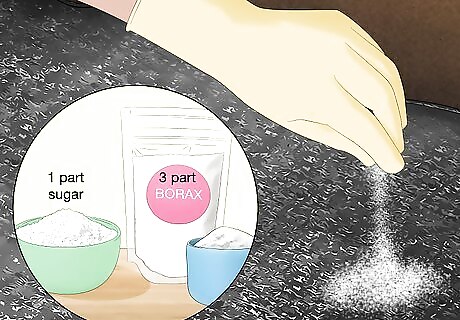
Combine boric acid with sugar and spread in the infected areas. Creating a mixture with sugar attracts the cockroaches to eat the Borax. Combine 3 parts Borax or boric acid with 1 part sugar and carefully spread the mixture around the surrounding areas. The roaches can take the mixture back to their nest, killing the whole colony. After a day or two, vacuum up the excess mixture and any carcasses left behind. Getting rid of roaches with Borax can be safer than traditional pesticides, however, use it with caution around pets and children—it can be harmful if ingested. Insecticide versions of boric acid are usually sold in cans or plastic squeeze bottles, and should be lightly dusted over carpets—cockroaches tend to avoid large hills of powder.
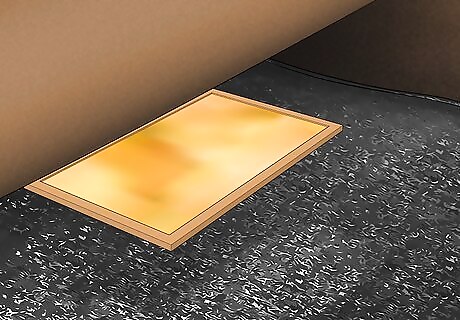
Place glue traps in tight cracks to figure out the extent of the problem. Glue traps are less effective than other remedies, but they may help you find out if your other efforts are working. Place them in tight cracks or near corners of the car where roaches might run through. After a few days, remove and discard the traps in a sealed plastic bag along with the roaches it collects.

Put down poisonous bait traps to kill the roaches. If any of the above methods don’t work, consider placing bait stations or gels near the edges of the car or where you have seen roaches. After several days, throw away the bait along with any roaches you might find. These baits usually have a scent that mimics roaches’ favorite foods, and when the roach eats it, it ingests the poison inside and dies. Bait traps are filled with poison that can harm humans and animals—consider not using poisonous bait around children or pets and try a different method instead. Bug bombs were once a popular roach killer, but recent research has found that they can be incredibly harmful to your upholstery, your electronics, and your health. Although it’s possible to use a bug bomb inside a car, the results aren’t worth the risk—try another method instead.
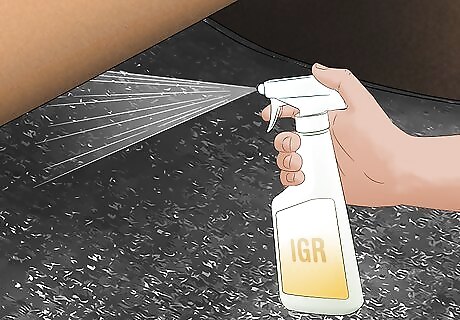
Spray Insect Growth Regulator (IGR) in affected areas. IGR is a solution that kills insects by disrupting their growth cycle. Spray an IGR solution in areas where you’ve seen roaches. After several days, clean up any roach carcasses you see. Consider steam cleaning your car to get rid of any odors and leftover IGR. IGRs tend to have a very low toxicity to humans and animals when applied according to the manufacturer instructions.
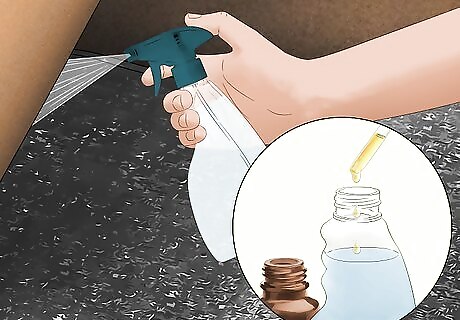
Spray essential oils directly or use them to repel roaches. One study found that rosemary, yarrow, and oregano oil were effective at killing roaches when sprayed directly on them. However, it may be more effective to repel them—combine a couple of drops of oil with water and spray onto surfaces where roaches are active. Other roach-repelling essential oils include: Oregano oil Rosemary oil Yarrow oil Mint oil Eucalyptus oil Ajowan oil Dill oil Cypress oil Cedar oil Catnip oil Some people say that using spices and herbs like live catnip are said to repel cockroaches, but these have not been found to be effective.

Use a steam cleaner to eliminate any residual odors. Detailing your car with a steam cleaner can be an effective way to remove bacteria, dirt, food odors, and pesticide residue from your car. Vacuum all mats, carpets, and upholstery before using your steam cleaner to remove dirt and debris from the inside of your car. You can also take your car to a detailer to have them professionally remove all scents and food particles that may be attracting roaches.

Call a pest control professional. If all else fails, consider calling a pest control specialist who can identify the problem, implement an effective roach killer strategy, and follow up to make sure the infestation is taken care of.
Keeping Roaches Out of Your Car

Get your car washed inside and outside regularly. Keeping your car clean can be the best way to make sure roaches never return. Avoid eating in your car whenever possible, clean up spills right away, and frequently wipe down the seats and clean the floor to remove any crumbs. Here are other ways you can keep your car clean: Every few weeks, pull up the floor mats and vacuum, making sure you get all the nooks and crannies. Get a bag or a box and gather everything you’ve been meaning to put inside with you to reduce any places that cockroaches can hide. Go to the carwash at least once a month to make sure all the crevices on the outside of the vehicle are free of pests.

Inspect your car for roaches once a week. Roaches like to hide and breed in dark, warm areas, which can include blankets and pillows, the interiors of doors, floor mats and carpets, the car’s ventilation system, seats, stereo system speakers, and any storage areas inside the vehicle. Look for these signs of a roach infestation regularly: New allergy symptoms A new moist, oily, or musty smell Egg cases Shed skin or shells Droppings that look like coffee grounds or clusters of dark specks Visible live or dead insects

Inspect items for roaches before putting them in your car. Roaches can hide in suitcases, used furniture or appliances, shipping boxes, clothes, blankets, or grocery bags. Once you put an infested item into your trunk, the roaches can crawl out and make your car their new home—check for roaches before putting new items in your car.
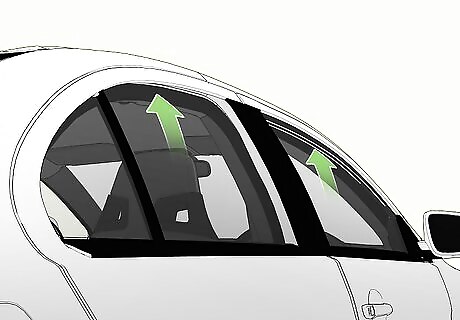
Keep your car windows and doors closed. Open windows are one of the common ways that cockroaches can make their way inside your vehicle, especially if you’ve parked your car in one spot for a long period of time. After driving, make sure that your windows are rolled up and try not to leave your car doors open for longer than you need to.

Park in clean areas that are completely free of roaches. If you park outside, avoid parking under trees or on dirt patches. Cockroaches may also live and breed in garages with lots of leaves, dirt, or food sources like pet food, books, sugar, flour, or glue. Clean your garage regularly and try to keep trash and stacks of firewood outside. If you have to park in a dirt area, make sure that your doors and windows are closed, keep the inside of your car clean, and seal any cracks and seams to make sure roaches can’t enter.

Seal the cracks and seams in your car. Roaches can also get into cars through small openings that lead to the cabin, like holes in the sunroof or windshield, gaps in the door, or damage in the car’s undercarriage. Apply silicone caulk or weatherstripping to any cracks around doors or windows. You can also contact your local mechanic to have them inspect your car and seal any cracks or seams properly.
Why do cockroaches get inside of cars?

Roaches like the heat, fermented food, and water that can be found in cars. If you have an infestation, your car might be providing roaches warmth, food, or access to water. Roaches are omnivores that eat rotten meats, fresh fruit, sugar filled foods, or anything with a strong odor, but even just a bottle of open water can invite them to move into your car. For example, crumbs stuck between the seats, spilled soft drinks, exposed adhesives, cardboard, newspapers, cosmetics, wrappers, or old lunchboxes can attract roaches. This is the reason why it’s so important to deep clean your car first and remove any items that might be attracting them to your car.
Types of Roaches

American cockroaches American cockroaches are reddish-brown, measure about 4 cm in length on average, and can be found in moist dark areas. They travel fast, spend the day hiding in cracks and crevices, and can pick up disease-causing bacteria, fungi, and viruses on the hair on their legs, which can be harmful to humans and animals.

Brown-banded cockroaches Brown-banded cockroaches have two light brown bands across their bodies, and only grow to about ½ in (1.3 cm) long. They can easily go undetected because of their small size and their nocturnal habits. This species lays about 14 egg capsules during their lifespan that each contain about 10 to 18 eggs.
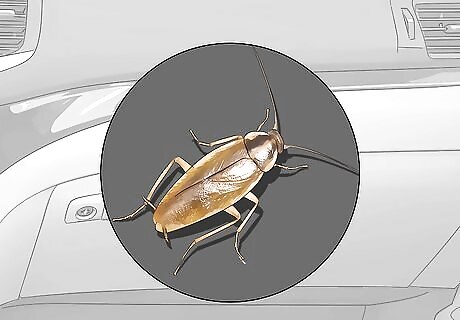
German cockroaches German cockroaches can be found all over the world, in almost every other building. They’re about ½ in (1.3 cm) long and brown with two parallel stripes on their chests, and can contaminate food by spreading pathogens. German cockroaches reproduce at an alarming rate—a typical egg case can carry around 40 eggs.




















Comments
0 comment